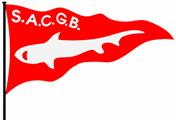Gallery and information showing in the Sardine Factory Heritage Centre in Looe.
This touch screen display has been provided by the Shark Angling Club of Great Britain (S.A.C.G.B.) and Angling Heritage UK to show the history of shark fishing through a slideshow of photographs taken over the years.
The S.A.C.G.B. was started in 1953 as it was realized that there were a significant number of sharks offshore which damaged the fishing nets and businesses of commercial fishermen, which could provide sport to anglers. At this time, all sharks were returned to port dead. The bigger ones were weighed and anyone catching a shark over 40lbs (later 70lbs) qualified to join the S.A.C.G.B. This has now been changed to 70”for a blue shark, 48” for a Thresher, 55” for a Porbeagle and 58” for a Mako Shark.
As membership grew, the S.A.C.G.B. held an annual dinner for members where trophies were awarded for notable captures, and also had a bar decorated with sharking memorabilia, where members could meet.
As times have changed, the sharks are now released alive after capture, and are often also tagged to enable scientists to carry out research about the species and aid its conservation. Angling is the only way to do this and return live fish to the sea.
Data has shown that sharks pulled on board over the gunwales (the side of a boat) can cause damage to their internal organs. Nowadays most boats are fitted with side doors to get the shark aboard without lifting, all of which helps preserve the species, and in the last couple of decades, data has shown shark numbers have risen quite markedly, as the practice of finning (commercial fishermen cutting the fins of live shark before throwing them into the sea to die) has been outlawed in the UK.
Although the UK and European Union still commercially land and sell sharks, including ‘At Risk Species’ to the world markets, including the practice of leaving the fins on by a small tag of flesh so that they are still, technically, attached!
We hope you will find the photographs of interest and appreciate how times have changed as anglers have progressed from their methods in the 50’s and 60’s to arguably the shark’s greatest protectors of the 21st century.
Please feel free to use the touch screen to see a wealth of angling history, you can interact with the screen by touching the boxes to look at photographs, videos and listen to recordings. You can even use the search box to look for a person or subject that interests you.
Angling Heritage UK, a not-for-profit trust was formed to preserve angling history and if you would like to help or add anything to the archive you can contact them through the website www.anglingheritage.org


































